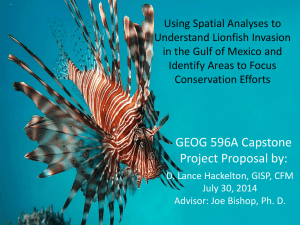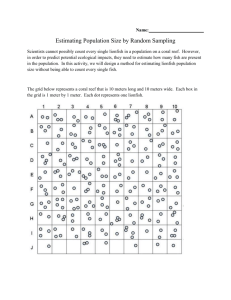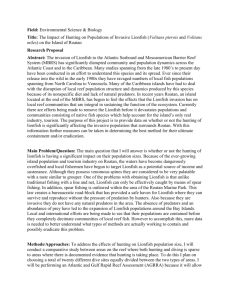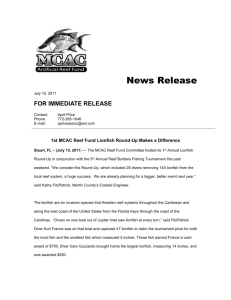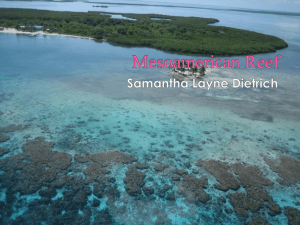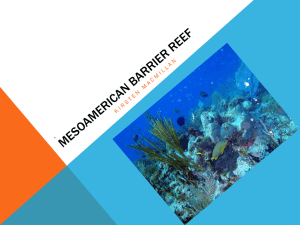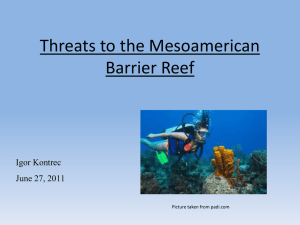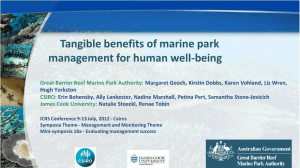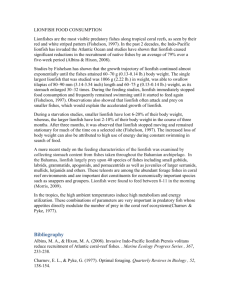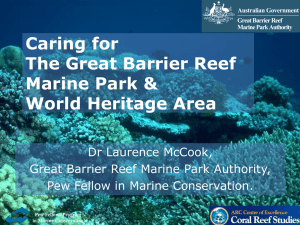Mesoamerican Reef-environment impacts
advertisement
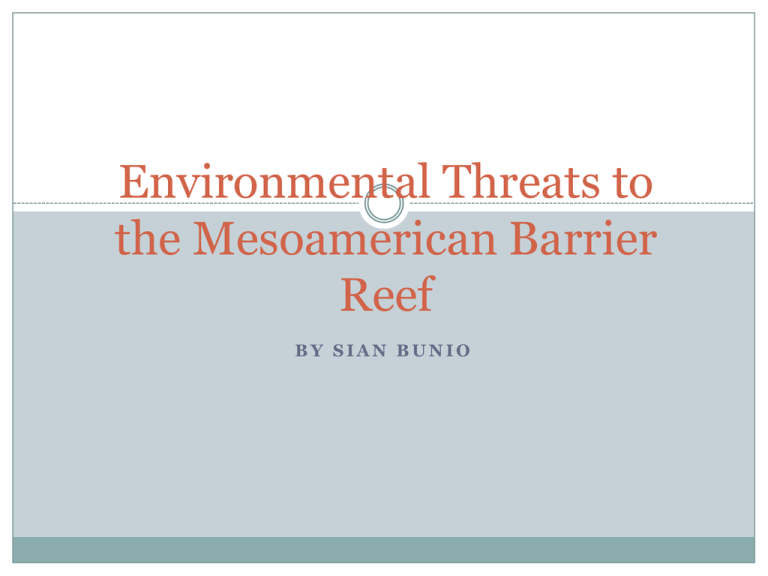
Environmental Threats to the Mesoamerican Barrier Reef BY SIAN BUNIO Introduction The Mesoamerican Reef is the 2nd largest in the world and stretches along the coasts of Belize, Mexico, Guatemala and Honduras. It offers wetlands, lagoons and coral reefs. Recently there has been a need for establishing plans and policies to protect the marine ecosystem surrounding the reef. Farming and mining practices as well as unwanted species will be evaluated as possible threats in the preservation of the reef. Farming Effects Erosion is a natural process which, by the wind the, the water and other natural elements, removes the soil layer by layer. Although it is a natural process human impact has increased the amount of run off. Through farming and the use of fertilizers with high levels of phosphorus and nitrogen the run off from the land contains more pollutants than ever before. The increasing demand for construction materials has led to deforestation. This increases the amount of nitrogen in the soil, because the nitrogen fixing bacteria in the roots of trees are not capable of absorbing it for other uses. Toxic substances such as herbicides and pesticides can become very harmful to the barrier reef ecosystems. As the toxic substances get into the food chain biomagnifications causes the concentration of toxins in the organisms to increase. The higher up the food chain it goes the more harmful it becomes. Mining Effects The idea of sea mining emerged in the 1960’s with the goal to extract minerals such as copper and zinc. Many countries wish to exploit the resources the under water environment has to offer. Consideration for the fragile ecosystem has been greatly neglected. By mining underwater the surface of the floor will rise up and bring with it sediments that can affect the organisms in the habitat. The currents could carry these pollutants into different areas and affect other ecosystems. The analysis of the consequences has not been fully completed which indicates that the deep sea mining exploitation is an unstable way to retrieve resources. British Petroleum Oil Spill On April 20, 2010 BP spilled more than 25,00 barrels of oil a day into the northern Gulf of Mexico after the oil rig exploded and sank. Oil from the rig flowed from the floor to about one mile until the spill was capped on July 15. The extent of the damage to the marine ecosystem is yet to be fully determined. Effects The oil spill created many problems. The oil on the surface of the water prevented oxygen from reaching the organisms below which needed it to survive. Many animals who lived on the surface or needed to reach the surface for air were unfortunately coated with the thick substance. Oil Spill Clean Up The oil spill in April 2010 was the largest oil spill in the new Millennium . Marine danger was imminent at that time and now the efforts to suppress the damages are satisfactory. The coastal community had come together to address the problem. Louisiana state authorities had closed all commercial and recreational fishing east of the Mississippi river and volunteers had come from the cities to help the authorities clean beaches and save wildlife. http://www.whitehouse.gov/blog/ 2010/08/06/west-wing-weekdispatches-gulf Mesoamerican Reef Species The Mesoamerican Barrier Reef is home to many different species. This rich tapestry of organisms provides a ecosystem for many different populations. It ranges from species such as the endangered salt water crocodile to sea turtles and back to mammoth whale sharks. Unwanted Species The lionfish is a venomous marine fish that is found mostly in the Indo-Pacific and aquariums. They are characterized by their red, white and black stripes and spiky tentacles. In the 1990’s they were unintentionally introduced into the Atlantic ocean after an aquarium turned over. They eat most species of fish and have become a sizable predator. In the past 10 years the population size has increased at a rapid speed. They can produce 30 thousand eggs every 4 days and with no competition the lionfish population continues to grow. Soon enough the large population with have to extent their boundaries and will make their way into the Mesoamerican Reef ecosystem. Lionfish The consumers below the lionfish in the food chain would suffer significantly because their population is limited to the level below theirs. With the increase of lionfish the other levels would not be able to keep up and therefore possible disappear in that area. With the expansion of the lionfish in other geographical locations this could be a ongoing problem. In the Florida Keys they have come up with a resolution to the expanding lionfish population. Every year they host a lionfish hunt competition, where divers collect as many lionfish as they can. This tournament allows for the population of lionfish to be monitored. Lionfish Lionfish in the Florida Cays: http://www.youtube.co m/watch?v=rxz4pwML 2s&feature=player_embe dded Protective Measures The Lionfish hunt in the Florida Keys is one example of how the inhabitants are doing their part to protect the aquatic ecosystem. By collecting lionfish once a year the number goes down which in turn balances out the food chain so there is not a large gap between consumer numbers. With a less rapid increase in the population, the geographical expansion will be reduced, positively affecting other marine ecosystems and their species. Proposal The Mesoamerican Leadership Program has a goal to conserve the reef and other ecosystems like it by prompting conservation projects which will tackle the main threats to the reef. These threats include run off of pollutants, global warming, oil spills, excessive fishing and unwanted species. Its mission is to help locals develop conservation projects which can improve conditions all along the coast. The mission is monitored by the leadership program. Each community must vary their priorities locally to create a meaningful impact. This program motivates local leaders to come forward and empower them to help develop projects which envelope the idea of sustainable use and conservation of the reef across the 4 countries. Proposal The potential long term impact is that within the next 5 years the project plans to launch sixty conservation projects that will have significant impact to the health of the reef. The World Wildlife Fund (WWF) works with Belize, Mexico, Guatemala and Honduras to manage the reef as an entire ecosystem. The project is funded by the Global Environment Facility. Conclusion The Mesoamerican Reef is a natural wonder that must be preserved. Even though it remains relatively intact there is the threat from tourism, deforestation, erosion, run off and global warming. All effect the reef in a different way. The reef is linked to numerous habitats and ecosystems which could all be damaged in the event of drastic change. It is important to act now to protect the biodiversity of the future. By finding alternative means to protect this ecosystem the biodiversity of this jewel will feel less pressure and have a promising future. References Images http://archive.wri.org/image.cfm?id=2679 http://nasailor.com/2010/11/23/lionfish-hunting-season-isopen-on-florida-coast/ http://www.turneffeatoll.org/videos/problem-of-invasivespecies http://www.oilspillnews.net/wpcontent/uploads/2010/09/1284519617-74.jpg http://www.grandpacliff.com/Animals/Fish/ImgSharks/shark-whale-mouthopen2-pt.jpg http://cancun.travel/en/files/2008/08/submarina.jpg http://4.bp.blogspot.com/XJJAs93Exj4/TYFpbJjwllI/AAAAAAAAAF8/RxnGA_N_Dws /s1600/1297695646-86.jpg References Farming and Mining http://pdf.wri.org/reefrisk_caribbean_landbased.pdf http://www.theecologist.org/News/news_analysis/653840/how_dee psea_mining_could_destroy_the_cradle_of_life_on_earth.html BP Oil Spill http://www.keysnet.com/2011/06/25/352421/researcher-on-bpspill-if-it-happened.html http://www.environmentalleader.com/2010/05/03/bp-oil-spillclean-up-to-cost-nearly-5-billion/ Proposal http://www.globalgiving.org/projects/save-the-mesoamerican-reef/ http://www.nationalgeographic.com/wildworld/profiles/g200/g235. html
